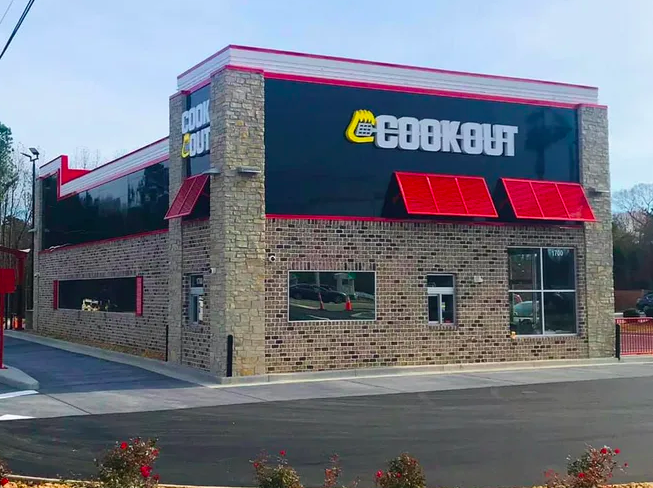Want to franchise a Party City? I have bad news for you. Party City no longer offers franchise opportunities to individuals. But don’t throw yourself a pity party just yet. In light of this, I’ll be covering the history of the Party City franchise, including past franchise costs and fees. The silver lining is there are still ways to invest in this concept if you find the business model attractive.
I’ll also review alternative franchises to Party City and how they compared in general cost to owning and operating a Party City location. You can also take our 7-minute quiz to find a franchise opportunity that’s still available.
Page Contents
What is Party City?
Party City is a discount party supply store that started in 1986 and remains a household name in party supplies. The company became a cornerstone in the party supply industry, founded by Steve Mandell, which was previously largely mom-and-pop stores. One of the biggest draws of Party City is the ability to get all kinds of party supplies in one location.
For example, Party City supplies decorations and costumes all in one location if a customer is looking to plan a Halloween party or put together a bridal shower or another event. The store boasts a wide range of party goods in one location, including build-your-own goodie bags, table decorations, and costumes. Each location is geared toward making party planning simple and efficient thanks to the color-coordinated organization.
According to an interview with a former Party City owner and manager, 20% of Party City’s storefront profits came from balloons. This was a unique niche for the business even as online retailers like Amazon began to creep into the party supply market, as delivering balloons was a complicated endeavor well beyond the scope of mass online sales.
While brick-and-mortar Party City stores are less common than in the early 2000s, Party City is uniquely a storefront and chain supplier, with products in stores worldwide. As a result, if a grocery or box store sells party supplies, in many cases, those supplies come from Party City’s supply chain, giving them a unique linchpin in the party supply industry.
You Might Like: How Profitable is a UPS Store? How Much Will it Cost to Open?
In their 2017 report, Party City noted they provide over 40,000 locations with party supplies, accounting for just under 50% of their total 2021 profits compared to their box store annual net sales.
By diversifying its sales methods, Party City controlled the party supply business on both fronts, providing supplies to competitors while offering its own goods at a reduced price.
However, this business model may be declining, as shown by Party City’s most recent fiscal report. But first, let’s take a look at the history of Party City and how the company shifted to public trading over franchising.
Franchise Facts
Party City initially began franchising from the start in 1986. However, as of 2005, the company shifted from the franchise model and moved toward publicly traded stock and company-run locations. However, the business is still open to investors, even with the shift from a franchise model to a company-run supply chain. After a brief period of unlisting from public trade in 1999, Party City is back to being publicly traded and is always looking for investors.
| Year Founded | 1986 |
| Year of IPO (Initial Public Offering) | 1996 |
| Total Units | More than 750 |
| Industry | Gifts and novelties |
Is Party City Going out of Business?

Is the party over for this company?
As of the writing of this article, Party City is still in operation. However, due to missed Q3 goals and the impact of inflation, the company plans to lay off 19% of its corporate workforce, signaling potential issues for the company.
As of December 12, 2022, the company faces restructuring, causing investors some concerns. In addition, a YTD look at the company’s stock shows a drop totaling 90% compared with the start of the year, which is not a good sign for the flagging company.
According to Bloomberg, Party City carried $1.8 million in debt compared to the meager $121.5 million earnings in the Q3 of 2022. This does not bode well for the party franchise and should be a sign to investors to reconsider investing in the company before its restructuring. While there is potential for the business model to turn around in the next year or two following an analysis of the company and its supply chains, things aren’t looking good for this party goods staple.
On top of this, the cost of shipping paired with helium supplies spells potential disaster for one of the company’s leading sources of revenue. While profits were marginally higher than in 2019, the pandemic and inflation have put Party City in danger of defaulting on their loans and facing potential bankruptcy despite staff cuts.
In recent news, Party City also faced Chapter 11 bankruptcy. An estimate of over $1 billion to $10 billion of assets and liabilities were reported. In addition, they also reported $150 million in debtor-in-possession financing just to be able to continue to support their operations.
Is Party City a Publicly Owned or Private Company?
In 1996, Party City became publicly owned and operated. However, the company went unlisted on the stock exchange in 1999, only to return a few years later. At the time of this writing, Party City’s shares were down 90% from the start of the year, with many shareholders selling before the company’s restructuring.
Public shareholders in the company have declined following fiscal uncertainty for the company. Listed primarily as a “penny stock,” Party City has seen a distinct drop in stock worth in 2022, with board members preparing for a restructuring of the company. Moreover, with company layoffs reaching 19% and the threat of defaulted loans, the financial outlook for Party City is rather grim.
Financial Requirements
With Party City in financial trouble, let’s look at a base analysis of the financial investments needed to franchise a Party City location. First, remember that the company no longer offers franchise opportunities, meaning these numbers are a ballpark estimate.
| Liquid Capital | $1,000 |
| Net Worth | N/A |
| Total Investment | $153,000 to $325,000 |
| Franchise Fee | $25,000 to $35,000 |
| Royalty Fee | 2% |
It is worth noting that the overall franchise fee for starting a Party City location is much lower than that of other franchises. In addition, it is worth noting that not only could we not find any net worth requirements for franchising with Party City, but the company offered financing in the past.
Since these numbers are flexible and do not consider current retail costs, comparing the relative ease of opening a Party City location to other franchises today is fascinating. For example, the initial cash requirements are incredibly low, especially compared to other retailers.
The total royalty fee of 2% is also incredibly low. For comparison, most franchises expect anywhere between 4.5% and 6% depending on the company.
Even considering the cost of real estate and construction on a new store location, the investment required to open a Party City location is incredibly accessible. Take Dollar Store Services; a company focused on helping individuals start their own dollar store locations, as a counter-example. This company requires $40,000 in liquid funds, compared with the previous Party City requirement of $1,000, or has as much as the average New York City renter pays on a one-bedroom apartment in one month. Dollar General is another option that offers some party related items and requires an investment between $100,000 – $600,000.
One potential reason for the low cost of starting a Party City location is the supply chain monopoly. Since Party City produces such a significant portion of its own goods, the price of acquiring products is lower than if it sourced them externally.
Additionally, Party City can offer name-brand merchandise that could attract more customers due to a working relationship with high-profile brands, including Disney and Nickelodeon, and other children’s character brands.
Average Sales / Revenue per Year
To explore the current downturn in Party City’s business model, we’ve analyzed their annual systemwide sales and average annual sales from 2021.
While the company does not provide individual sales information for each location, given that Party City owned and operated 750 retail units, their revenue was reported to be around $2.16 billion in 2022.
Since Party City does not operate under a franchise agreement, this is a more significant estimated profit than some other retailers as they do not acquire a percentage of royalties and instead receive a net sum.
Party City 2024 Financial Report Highlights
| Revenue (2024) | $2.16 billion |
| Estimated Average Unit Volume (2024) | $2.688 million |
Since Party City no longer offers franchising, there has been a lack of financial data made in public. But if we comparing their numbers with their 2022 Q3 report, Party City reported $510.2 million in Q3 of 2021. Adjusted for 2022 inflation rates, the 2021 Q3 total is $464.3 billion. The 2022 Q3 amount of $121.5 in net sales is a 282% decrease from the previous year, indicating how far Party City has declined in a single calendar year.
By comparing the net profits over the past two years, not considering comparable years of operation, Party City’s retail sales have significantly flagged. Pairing this with the cost of shipping and delivery, the global helium supply, and the decreased spending of the average consumer due to inflation, this party supply franchise has very little worth celebrating.

Quarterly business performance of Party City.
It is possible that Party City could make up some of the deficit in their Q4 reports due to the company’s position as a Halloween goods store. In addition, by combining Halloween and Christmas purchases, as well as Black Friday deals, there is potential for the company to regain some funds in Q4.
However, given the previous three quarters of operation and the fall in stock prices, corporate layoffs, and restructuring, finding a source of revenue equal to $1.8 billion in outstanding debts is unlikely.
Investment Overview
Party City is undergoing a rocky financial period. While a single year of low performance is not necessarily an indicator of a dive due to Party City’s relatively low assets and previous years’ performance, leading financial experts advise waiting for the dust to settle before investing in the company.
Any company facing restructuring is in for a certain amount of fluctuation. In the case of Party City, corporate layoffs on a nearly 1 in 5 scale indicate financial instability and an almost desperate need to reduce costs. While the company has shown it’s looking into updating its technology and shipping systems and optimizing store locations, it is unlikely we’ll see significant improvements before a total restructuring.
You Might Like: Franchise vs License: What’s Different? What’s Better?
Even if you are looking to invest in “penny stocks,” Party City is steadily declining, with its stock at a 90% or more decrease compared to the start of 2022 alone. Because of the expected business instability as it restructures and a high likelihood of bankruptcy, it’s advisable to look into other penny stock investment opportunities over putting your funds toward Party City.
While one would hope that Party City isn’t going to go the way of most ’90s trends, the current fiscal reports, coupled with inflation and growing economic instability, may signal the end for this party supplier.
Is Party City the Right Investment for You?
If there’s one takeaway from this article, Party City is not the best investment choice if your goal is to start a franchise. Why? Because you can’t actually start a new franchise anymore. Also, according to analysts financial estimates are primarily pessimistic for Party City the next 12 – 24 months while the company potentially restructures further.
Since Party City doesn’t offer franchise opportunities, take our franchise quiz be matched with an opportunity that fits your budget and interests. Comparing franchise fees and profitability has never been easier, from restaurants to financial franchises and everything in between.





